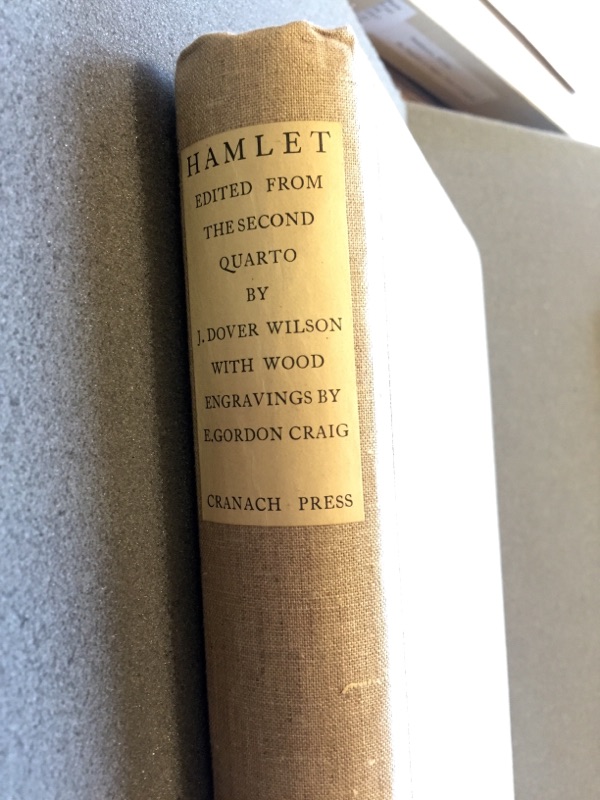Making Of A Tragedie
Our object is on The Tragedies of Hamlet Prince of Denmarke. It was edited by J. Dover Wilson LITT. D. from the text of the second Qvarto, which was printed in 1604-1605. The center of the book contains Shakespeare’s actual words that have been translated in Latin, French, and English. The physical appearance of the book starts with a plain light grey hardcover with no title. The book’s size is about the size of an average laptop, so it is harder to travel around with. The texture of the book feels rough. The inside of the book contain pages that have illustrations and the text style is like old English text and the writing style is like terse style in which few words contain a lot of meaning. The only color in the book besides black are the red words on the top of the pages that represent each act and section number. Because the play is a tragedy, perhaps the red represents that blood that is being shed. The pages itself are heavy and thick and because this book is very old, the edges of pages has a smudge of yellow. The feeling of the book itself is like a classical and strong cultural ambience.
One of the fascinating features of the book is that the margins on this book contains the source texts which Shakespeare pulls information from to help him create The Tragedies of Hamlet Prince of Denmarke. Another interesting feature of the book is that there is hidden book at the end of the book. This mysterious second book is actually footnotes to help readers understand Shakespeare’s writing. The cover of this book is exactly the same as The Tragedies of Hamlet Prince of Denmarke: plain light grey hardcover. They have two sources on same page. One is written in English the other is written in French. The two sources being together could help readers understand Shakespeare’s intentions while writing the play.

Welcome Shakespeare lovers!
We have created a video to show the reactions of several characters in Hamlet during one on one interviews.
Copy and paste the link below to see our work. Enjoy!
Critical Paratext about Creative Interpretation
Our object is The Tragedies of Hamlet Prince of Denmarke and we decided that our creative interpretation of this object would be a news coverage parody. It is a modernized version based on important scenes from Hamlet. As a group, we decided that a video parody was the best medium to interpret The Tragedies of Hamlet Prince of Denmarke rather than through dance or music or some other type of physical medium. We chose to do this creative interpretation because we thought it would be a fun, humorous, and interesting way to show people around the world how we, as a group, interpret Shakespeare’s Hamlet.
The modernization of Hamlet makes the content more relatable to people. The news coverage and Hamlet have many similarities. It not only includes significant scenes such as: the ghost appearing to Hamlet, Hamlet seeking revenge for his father and his madness, Claudius’s extravagant plan to kill Hamlet, and poor Ophelia’s death, but it will also all eventually lead up to the big reveal of Prince Hamlet’s tragedy: his own death. Hamlet’s obsession with getting revenge on those who wronged him ultimately led to his own downfall. The newscast parody shows the major events of Hamlet in a modern adaptation. If Hamlet were to be retold through a news station today such as CNN or FOX, we would think it would be interpreted some way similar to ours. There is also a news anchor who interviews each person and shows each person’s point of view just like a news anchor today would do.
We hope the viewers that are watching this short newscast parody can feel not only the emotions of each character as they come to life on screen, but also the character developments of Hamlet and invest into each individual character’s personality. We hope that the viewers will enjoy watching our work as much as each one of us enjoyed interpreting our characters in this unique style. Ideally, this modern version of Hamlet will interest people from different regions of the world and encourage them to read the original Shakespeare’s text which was translated to not only Latin and French, but English as well. The original Hamlet is roughly 400 years old but the major themes such as drama, madness, revenge, and family are still relevant today in this time period just like it was in 1603 and can be enjoyed by everyone.